Related Research Articles

Jorge Francisco Isidoro Luis Borges Acevedo was an Argentine short-story writer, essayist, poet and translator, as well as a key figure in Spanish-language and international literature. His best-known books, Ficciones (Fictions) and El Aleph, published in the 1940s, are collections of short stories exploring themes of dreams, labyrinths, chance, infinity, archives, mirrors, fictional writers and mythology. Borges's works have contributed to philosophical literature and the fantasy genre, and majorly influenced the magic realist movement in 20th century Latin American literature.
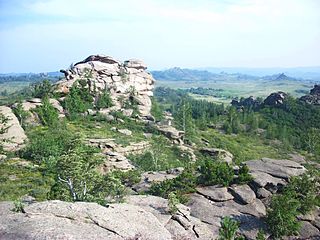
A tor, which is also known by geomorphologists as either a castle koppie or kopje, is a large, free-standing rock outcrop that rises abruptly from the surrounding smooth and gentle slopes of a rounded hill summit or ridge crest. In the South West of England, the term is commonly also used for the hills themselves – particularly the high points of Dartmoor in Devon and Bodmin Moor in Cornwall.
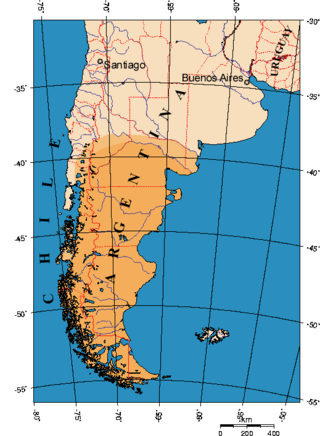
Patagonia refers to a geographical region that encompasses the southern end of South America, governed by Argentina and Chile. The region comprises the southern section of the Andes Mountains with lakes, fjords, temperate rainforests, and glaciers in the west and deserts, tablelands and steppes to the east. Patagonia is bounded by the Pacific Ocean on the west, the Atlantic Ocean to the east, and many bodies of water that connect them, such as the Strait of Magellan, the Beagle Channel, and the Drake Passage to the south.

Isla de los Estados is an Argentine island that lies 29 kilometres (18 mi) off the eastern extremity of Tierra del Fuego, from which it is separated by the Le Maire Strait. It was named after the Netherlands States-General, the Dutch parliament.

La Pampa is a sparsely populated province of Argentina, located in the Pampas in the center of the country. Neighboring provinces are from the north clockwise San Luis, Córdoba, Buenos Aires, Río Negro, Neuquén and Mendoza.

Sea of Death is a Brazilian Modernist novel written by Jorge Amado. Amado wrote the novel in response to his first arrest for "being a communist". The novel follows the lives of poor sailors around Bahia, and their relationship with the Afro-Brazilian religion Candomblé, especially the sea goddess Iemanjá. The novel's style and themes include many traits that characterize Amado's later work.
Gregory Rabassa, ComM, was an American literary translator from Spanish and Portuguese to English. He taught for many years at Columbia University and Queens College.
The Huanquihue Group is a group of young basaltic stratovolcanoes in Argentina near the border with Chile, south of Lanín volcano. The Huanquihue group is located south of Epulafquén Lake, north of Lolog Lake and west of Reigolil-Pirihueico Fault in Chile. Volcanism is associated with the Liquiñe-Ofqui Fault.
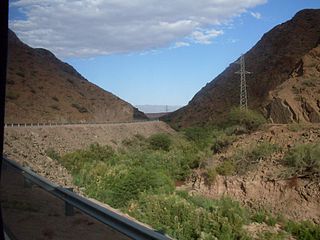
The Abaucán is a river in Argentina which flows through the provinces of Catamarca and La Rioja, areas with very low precipitation. The river water is provided by the ingress of two larger rivers, the Fiambalá and the Chaschuil.

Marcelo Jorge Fuentes is an Argentine Justicialist Party politician. He was a National Senator for the Neuquén Province for the Frente de Todos. In 2019, Fuentes, became Parliamentary Secretary to the Argentine Senate.
Jorge Oscar Racca is an Argentine-Italian retired male professional basketball player. At 6'6" and 218 lbs., he played at the shooting guard and small forward positions. Nicknamed "Pampa" during his career, Racca was a member of Argentina's national basketball team at the 1996 Summer Olympics.

Jorge Luis Sampaoli Moya is an Argentine football coach who was most recently the manager of Sevilla in La Liga. Sampaoli started out as a youth player and eventually switched to management after a severe injury.
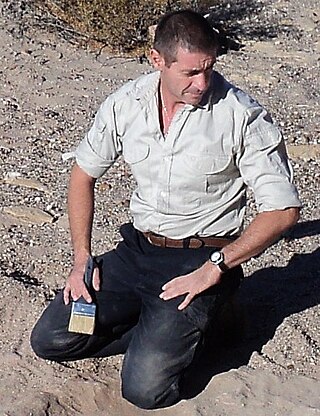
Jorge Orlando Calvo was an Argentine geologist and paleontologist working for "Centro de Investigaciones Paleontológicas Lago Barreales".
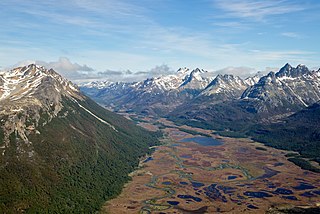
The Carbajal Valley is a valley in the Fuegian Andes of southern Tierra del Fuego Province, Argentina. The Carbajal valley is approximately 20 kilometres (12 mi) long, running west to east, between the Alvear mountain range to the north and the Vinciguerra range to the south. Andes peak heights in the region are generally less than 1,250 metres (4,100 ft) above sea level.

The last glacial period and its associated glaciation is known in southern Chile as the Llanquihue glaciation. Its type area lies west of Llanquihue Lake where various drifts or end moraine systems belonging to the last glacial period have been identified. The glaciation is the last episode of existence of the Patagonian Ice Sheet. Around Nahuel Huapi Lake the equivalent glaciation is known as the Nahuel Huapi Drift.
Fueguino is a volcanic field in Chile. The southernmost volcano in the Andes, it lies on Tierra del Fuego's Cook Island and also extends over nearby Londonderry Island. The field is formed by lava domes, pyroclastic cones, and a crater lake.

The Soatá Formation is a geological formation of the northern Altiplano Cundiboyacense, Eastern Ranges of the Colombian Andes. The formation consists mainly of shales with conglomerates and dates to the Quaternary period; Late Pleistocene epoch. The heavily eroded formation has a maximum measured thickness of 30.8 metres (101 ft). It contains the lacustrine and fluvio-glacial sediments of elongated paleolake Soatá, that existed on the Altiplano in the valley of the Chicamocha River.
Rabassa is a Catalan language surname. Notable people with the surname include:

The Pali-Aike volcanic field is a volcanic field along the Argentina–Chile border. It is part of a family of back-arc volcanoes in Patagonia, which formed from processes involving the collision of the Chile Ridge with the Peru–Chile Trench. It lies farther east than the Austral Volcanic Zone, the volcanic arc that makes up the Andean Volcanic Belt at this latitude. Pali-Aike formed over sedimentary rock of Magallanes Basin, a Jurassic-age basin starting from the late Miocene as a consequence of regional tectonic events.
Choconsaurus is an extinct genus of herbivorous sauropod dinosaur belonging to the group Titanosauriformes, which lived in the area of present-day Argentina at the end of the Cretaceous.